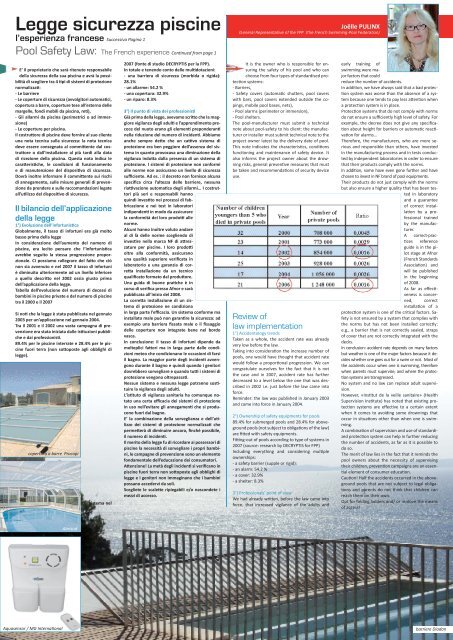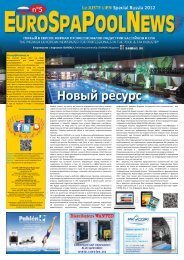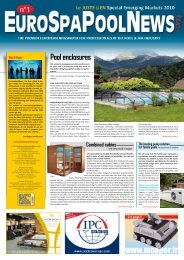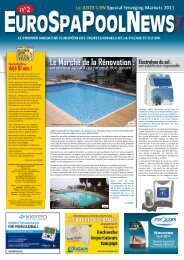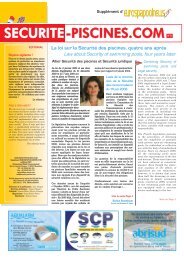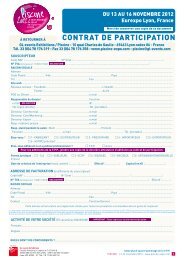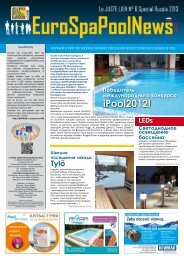Benvenuti a Milano - Eurospapoolnews.com
Benvenuti a Milano - Eurospapoolnews.com
Benvenuti a Milano - Eurospapoolnews.com
You also want an ePaper? Increase the reach of your titles
YUMPU automatically turns print PDFs into web optimized ePapers that Google loves.
Legge sicurezza piscinel’esperienza francese Successiva Pagina 1Pool Safety Law: The French experience Continued from page 1E’ il proprietario che sarà ritenuto responsabiledella sicurezza della sua piscina e avrà la possibilitàdi scegliere tra 4 tipi di sistemi di protezionenormalizzati:- Le barriere- Le coperture di sicurezza (avvolgitori automatici,copertura a barre, coperture tese all’esterno dellemargelle, fondi mobili da piscina, reti),- Gli allarmi da piscina (perimetrici o ad immersione)- Le coperture per piscina.Il costruttore di piscine deve fornire al suo clienteuna nota tecnica sulla sicurezza: la nota tecnicadeve essere consegnata al <strong>com</strong>mittente dal costruttoreo dall’installatore al più tardi alla datadi ricezione della piscina. Questa nota indica lecaratteristiche, le condizioni di funzionamentoe di manutenzione del dispositivo di sicurezza.Dovrà inoltre informare il <strong>com</strong>mittente sui rischidi annegamento, sulle misure generali di prevenzioneda prendere e sulle rac<strong>com</strong>andazioni legateall’utilizzo del dispositivo di sicurezza.Il bilancio dell’applicazionedella legge1°) Evoluzione dell’infortunisticaGlobalmente, il tasso di infortuni era già moltobasso prima della leggeIn considerazione dell’aumento del numero dipiscine, era lecito pensare che l’infortunisticaavrebbe seguito la stessa progressione proporzionale.Ci possiamo rallegrare del fatto che ciònon sia avvenuto e nel 2007 il tasso di infortuniè diminuito ulteriormente ad un livello inferiorea quello descritto nel 2002 ossia giusto primadell’applicazione della legge.Tabella dell’evoluzione del numero di decessi dibambini in piscine private e del numero di piscinetra il 2000 e il 2007Si noti che la legge è stata pubblicata nel gennaio2003 per un’applicazione nel gennaio 2004.Tra il 2001 e il 2002 una vasta campagna di prevenzioneera stata iniziata dalle istituzioni pubblichee dai professionisti.89.4% per le piscine interrate e 28.4% per le piscinefuori terra (non sottoposte agli obblighi dilegge).copertura a barre Procopi2°) Le percentuali di impiantiLe dotazioni delle piscine per tipo di sistema nel2007 (fonte di studio DECRYPTIS per la FPP).In totale e tenendo conto delle multidotazioni:- una barriera di sicurezza (morbida o rigida):28.1%- un allarme: 54.2 %- una copertura: 32.9%- un riparo: 8.3%3°) Il punto di vista dei professionistiGià prima della legge, avevamo scritto che la maggiorevigilanza degli adulti e l’apprendimento precocedel nuoto erano gli elementi preponderantinella riduzione del numero di incidenti. Abbiamoanche sempre detto che un cattivo sistema diprotezione era ben peggiore dell’assenza del sistemain quanto provocava una diminuzione dellavigilanza indotta dalla presenza di un sistema diprotezione. I sistemi di protezione non conformialle norme non assicurano un livello di sicurezzasufficiente. Ad es. : il decreto non fornisce alcunaspecifica circa l’altezza delle barriere, nessunariattivazione automatica degli allarmi… I costruttoripiù seri e responsabili hannoquindi investito nei processi di fabbricazionee nei test in laboratoriindipendenti in modo da assicurarela conformità dei loro prodotti allenorme.Alcuni hanno inoltre voluto andareal di là delle norme scegliendo diinvestire nella marca NF di attrezzatureper piscine. I loro prodottioltre alla conformità, assicuranouna qualità superiore verificata inlaboratorio e una garanzia di correttainstallazione da un tecnicoqualificato formato dal produttore.Una guida di buone pratiche è incorso di verifica presso Afnor e saràpubblicata all’inizio del 2008.La corretta installazione di un sistemadi protezione ne condizionain larga parte l’efficacia. Un sistema conforme mainstallato male può non garantire la sicurezza: adesempio una barriera fissata male o il fissaggiodelle coperture non integrate bene nel bordovasca.In conclusione: il tasso di infortuni dipende damolteplici fattori ma in larga parte dalle condizionimeteo che condizionano le occasioni di farsiil bagno. La maggior parte degli incidenti avvengonodurante il bagno e quindi quando i genitoridovrebbero sorvegliare e quando tutti i sistemi diprotezione vengono oltrepassati.Nessun sistema e nessuna legge potranno sostituirela vigilanza degli adulti.L’istituto di vigilanza sanitaria ha <strong>com</strong>unque notatouna certa efficacia dei sistemi di protezionein uso nell’evitare gli annegamenti che si produconofuori dal bagno.E’ la <strong>com</strong>binazione della sorveglianza e dell’utilizzodei sistemi di protezione normalizzati chepermetterà di diminuire ancora, finché possibile,il numero di incidenti.Il merito della legge fu di ricordare ai possessori dipiscine la necessità di sorvegliare i propri bambini,le campagne di prevenzione sono un elementofondamentale dell’educazione dei consumatori.Attenzione! La metà degli incidenti si verificano inpiscine fuori terra non sottoposte agli obblighi dilegge e i genitori non immaginano che i bambinipossano accedervi da soli.Scegliete le scalette ripiegabili e/o nascondete imezzi di accesso.Joëlle PULINXGeneral Representative of the FPP (The French Swimming-Pool Federation)It is the owner who is responsible for ensuringthe safety of his pool and who canchoose from four types of standardised protectionsystems:- Barriers,- Safety covers (automatic shutters, pool coverswith bars, pool covers extended outside the copings,mobile pool bases, nets),- Pool alarms (perimeter or immersion),- Pool shelters.The pool-manufacturer must submit a technicalnote about pool-safety to his client: the manufactureror installer must submit technical note to theproject owner latest by the delivery date of pool.This note indicates the characteristics, conditionsfunctioning and maintenance of safety device. Italso informs the project owner about the drowningrisks, general preventive measures that mustbe taken and re<strong>com</strong>mendations of security deviceuse.Review oflaw implementation1°) Accidentology trendsTaken as a whole, the accident rate was alreadyvery low before the law.Taking into consideration the increase number ofpools, one would have thought that accident ratewould follow a proportional progression. We cancongratulate ourselves for the fact that it is notthe case and in 2007, accident rate has furtherdecreased to a level below the one that was describedin 2002 i.e. just before the law came intoforce.Reminder: the law was published in January 2003and came into force in January 2004.2°) Ownership of safety equipments for pools89.4% for submerged pools and 28.4% for abovegroundpools (not subject to obligations of the law)are fitted with safety equipments.Fitting-out of pools according to type of systems in2007 (source: research by DECRYPTIS for FPP)Including everything and considering multipleownerships:- a safety barrier (supple or rigid):- an alarm: 54.2 %- a cover: 32.9%- a shelter: 8.3%3°) Professionals’ point of viewWe had already written, before the law came intoforce, that increased vigilance of the adults andearly training ofswimming were majorfactors that couldreduce the number of accidents.In addition, we have always said that a bad protectionsystem was worse than the absence of a systembecause one tends to pay less attention whena protection system is in place.Protection systems that do not <strong>com</strong>ply with normsdo not ensure a sufficiently high level of safety. Forexample, the decree does not give any specificationabout height for barriers or automatic reactivationfor alarms…Therefore, the manufacturers, who are more seriousand responsible than others, have investedin the manufacturing process and in tests conductedby independent laboratories in order to ensurethat their products <strong>com</strong>ply with the norms.In addition, some have even gone further and havechosen to invest in NF brand of pool equipments.Their products do not just <strong>com</strong>ply with the normsbut also ensure a higher quality that has been testedin laboratoryand a guaranteeof correct installationby a professionaltrainedby the manufacturer.A correct-practicesreferenceguide is in the pilotstage at Afnor(French StandardsAssociation) andwill be publishedin the beginningof 2008.As far as effectivenessis concerned,correctinstallation of aprotection system is one of the critical factors. Safetyis not ensured by a system that <strong>com</strong>plies withthe norms but has not been installed correctly:e.g., a barrier that is not correctly sealed, strapsof cover that are not correctly integrated with thedecks.In conclusion: accident rate depends on many factorsbut weather is one of the major factors because it decideswhether one goes out for a swim or not. Most ofthe accidents occur when one is swimming, thereforewhen parents must supervise, and where the protectionsystems are transgressed.No system and no law can replace adult supervision.However, «Institut de la veille sanitaire» (HealthSupervision Institute) has noted that existing protectionsystems are effective to a certain extentwhen it <strong>com</strong>es to avoiding some drownings thatoccur in situations other than when one is swimming.A <strong>com</strong>bination of supervision and use of standardizedprotection system can help in further reducingthe number of accidents, as far as it is possible todo so.The merit of law lies in the fact that it reminds thepool owners about the necessity of supervisingtheir children, prevention campaigns are an essentialelement of consumer education.Caution! Half the accidents occurred in the abovegroundpools that are not subject to legal obligationsand parents do not think that children canreach them on their own.Opt for folding ladders and/ or remove the meansof access!AbrisudAquasensor / MG International barriere Diodon


